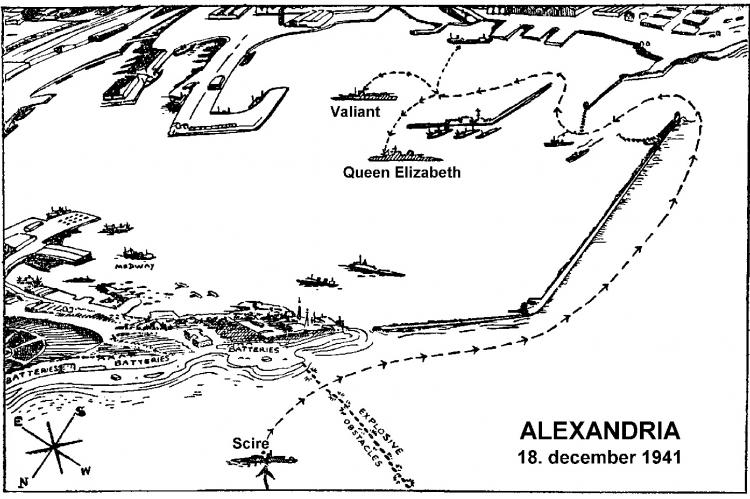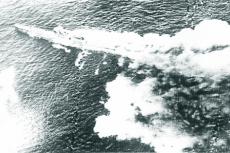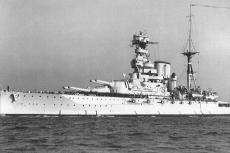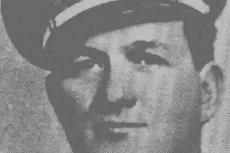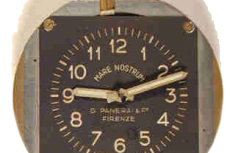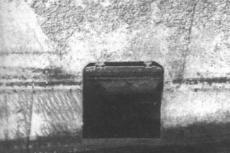First Frogmen - part 2
In the years prior to World War II, the Italian fleet had developed a new underwater weapon, the SLC, a slow torpedo which was manned by two divers. Submerged, and thereby unseen, the frogmen on the SLC could get close in to the enemy ships and mine them. The frogmen trained in attacking their own ships, and after many excercises developed a procedure for approach and placing mines under the ships.
Tags & Taxonomy
As soon as the submarine was in position, and the frogmen were out, the containers were opened and the SLC drawn out. The frogmen then tested all the functions of the SLC before setting out for the target. The first part of the trip took place on the surface, when only the heads of the frogmen were above the surface. The frogmen had full face masks on but breathed through a valve in the mouthpiece out to the air in order not to deplete the oxygen stores.
The harbours were generally barred by submarine nets which the frogmen had to pass either under or over. They could also cut their way through using wire-cutters. Free from the nets and into the harbour, the frogmen picked out the chosen target by its silhouette because the attacks took place at night. They had to get so close to the target that they could often hear and see the watch crew on the deck.
During the last part of the trip on the surface the sternmost frogman lowered his head beneath the surface and breathed using his oxygen apparatus, so that there was as little as possible to be seen by any watchmen on the ships. The leading frogman then also went over to breathing using his oxygen apparatus and was ready to release the air from the tank of the SLC. In that way could they quickly disappear from the surface if it happened, for example, that a searchlight could get close and illuminate them.
Acquiring the target
When the target had been identified, and at a distance of ca 30 meters from it, the leading frogman took a compass bearing and then let the SLC disappear beneath the surface. At about 8 to 10 meters depth the SLC was trimmed to sail horizontally. It was now cold, dark and quiet around the frogmen. As they slowly sailed towards the target the frogmen kept an eye on the remaining light filtering down from the surface.
When the light disappeared they knew that they were beneath the ship. The SLC was stopped and a little air was released into the tank between the frogmen so that the SLC now had a slight positive buoyancy causing it to rise up to the bottom of the ship. The frogmen raised a hand over their heads to take the force of contact with the ship’s bottom.
With one hand one the bottom of the ship they returned in the direction from which they had come until the stern-most frogman felt the bilge keel. The bilge keel is a thick piece of sheet-iron which runs along both sides of the hull in order to stabilise the ship against rolling. With a clap on the shoulder of the driver the stern-most frogman told the driver that he had found the bilge keel. He quickly took a clamp and a steel wire from the toolbox behind him and fixed the wire to the bilge keel using the clamp.
Two claps on the shoulder of the driver informed him that the wire was now fixed in place, and the SLC was now sailed over to the other side of the hull where the procedure was repeated. There was now a wire stretched out beneath the ship. Holding the wire the frogmen now pulled themselves to under the middle of the ship. The stern-most frogman now left his seat and crept past the driver in order to fix the mine, which formed the bows of the SLC, to the wire. At the same time the driver of the SLC held it fast between his legs.
After the mine had been fixed the timing mechanism was activated. This would cause the mine to explode 2½ hours later. He then released the SLC from the mine and crept back to his seat. Three claps on the shoulder of the driver told him that the task was completed, and that it was now time to get away. It was impossible to find a way back to the submarine and the frogmen, if possible, had to try and reach a neutral coast where they could sink the SLC. This procedure shown to be possible during training but was found to be much more difficult during operations against the Allies.
Attacking the British
On the 10th June, 1940 Italy declared war against England and France. It was now that the SLC could show what it could do. The first attack was planned for the night between the 25th and 26th August, 1940. The target was the English fleet in Alexandria. The submarine Iride took the frogmen from La Spezia to Bomba west of Tobruk, where Iride met the torpedoboat Calipso, which carried four SLC. This method of transporting the SLC was chosen in order to avoid damage to them should the submarine be forced into deep water.
On the morning of the 21st August, when the SLC were being transferred to Iride, and the submarine refuelled - ready to carry out a test dive – three English torpedo planes appeared on the horizon. They flew low over the sea and opened fire against Iride. A torpedo hit the submarine amidships and it immediately sank in 15 meters of water.
Rescue
Calipso immediately sailed to where Iride had sunk. They found that the frogmen and some of the crew had escaped from the wreck. Without oxygen equipment – it was in the Iride - the frogmen dived down to the submarine and connected a buoy to it. A message was sent to Tobruk asking for help, and after some time a diver arrived with some diving equipment. The frogmen and the diver made contact with the survivors in the submarine using knocking signal. The crew of the submarine signalled that the external hatch of the sluice could not be opened from inside.
The hatch was stuck tightly in the hatch frame by the explosion. However, the frogmen and the diver succeeded in opening the hatch but it was damaged and could not be closed tightly. The frogmen signalled to the crew of the submarine that they should open the second hatch into the hull and attempt to reach the surface. The order was discussed in the submarine but they thought that the crew preferred to remain in the submarine. It was signalled from outside to the trapped crew that they should come out within half an hour or they would be left to their fate. There was no answer.
From the deck of the Calipso the frogmen maintained a watch on the sea and hoped that the crew in the submarine would take a chance rather than await the inevitable. After some time a large amount of air was released from the submarine – the hatch had been opened – and the survivors appeared one by one on the surface after being trapped for 24 hours on the bottom of the sea.
”Enemy ship 800 meters”
The next attempt was made in September 1940. The Italians would attack two English fleet-bases simultaneously – Alexandria and Gibraltar. The submarine Gondar sailed for Alexandria and Scire for Gibraltar. After 9 days at sea the Gondar reached Alexandria on 29th September. At the time intended for the operations to start Gondar received a radio message from Rome: ”The English fleet has left harbour – return to Tobruk”.
The disappointment was great, so close and so had the fleet left harbour. They were very close to the naval-base and probably a watch at the base had observed the submarine and raised the alarm. After just a few minutes sailing the alarm sounded on the submarine: ”Enemy ship 800 meters”. Gondar dived immediately, and a hunt now began during which Gondar was under constant bombardment by depth-charges, causing it to dive deeper and deeper.
The hunt continued all night, and in the morning at 8 o’clock the Gondar could not take it any more and began to sink uncontrollably. All the air was blown into the tanks in order to stop the dive. It succeeded, and the Gondar stopped at 155 meters, but now an uncontrolled rise to the surface began with an ever increasing speed. The crew got ready to abandon the submarine as soon as it had reached the surface. Gondar floated on the surface for only a few minutes before it again sank. In spite of this, all the crew excepting one managed to escape from the wreck. The attacking destroyer collected up the surviving frogmen and submarine crew, among them Toschi who spent the rest of the war as a prisoner.
Attack on Gibraltar
Scire reached Gibraltar at the same time as Gondar reached Alexandria. Just 50 miles from Gibraltar and 4 hours prior to the planned attack Scire received a radio message: ”The fleet has left harbour – return to La Maddalena”. This time was not a success either. The English had apparently detected one of the submarines but didn’t know its intentions.
They were ready for yet another attack on Gibraltar in October 1940. Under the command of Valerio Borghese the Scire would transport three SLC to Gibraltar, where they would attack the English battleships. The frogmen were the same as were recalled from the previous mission. This time the frogmen were with the Scire the whole way from La Spezia to Gibraltar. The Scire reached the Straits of Gibraltar on the 27th October. Two days later the Scire, submerged and against the strong current, succeeded in entering the Strait.
Outside the Bay of Algiceras, where the fleetbase was situated, the Scire waited 70 meters down on the rocky bottom to await the coming night. Sounds could clearly be heard in the submarine from the shipping traffic. In the evening the Scire sailed slowly into the bay. Only the most absolutely necessary equipment was in operation, and the crew avoided any unnecessary noise in order not to be detected. They constantly heard the noise from the screws of the patrol boats passing over them.
Around midnight they were in position 3 miles from the fleet-base, and the submarine rose to the surface in order to launch the frogmen. Here they received the latest messages which stated that there were two battleships in the harbour. All was now ready, and after a short time on the surface the Scire dived again and crept out of the bay. The frogmen were now on their own. After they had completed their operation they should aim for the Spanish coast where an Italian agent awaited them and who would ensure their transport back to Italy.
Equipment breakdown
The SLC of De La Penne and Bianchi was the first to fail. After sailing for about 20 minutes De La Penne dived to avoid a searchlight. At a depth of 15 meters the engine stopped and the SLC dropped to the bottom at 40 meters. It proved impossible to restart the motor, so the frogmen swam to the surface, got rid of their oxygen equipment and began swimming towards the Spanish coast.
Tesei and Pedretti got right in to the north mole of the naval base, only to discover that one of the oxygen apparatuses was filled with water and the other had other malfunctions. The reserve apparatus also proved to be unusable. Furthermore, it was not possible to trim the SLC which was sloping downwards towards the stern. The frogmen decided to call off the operation. They dropped the explosive charge and sailed off towards the Spanish coast.
Attack on HMS Barham
Birindelli and Paccagnini also had problems in trimming the SLC. One of the oxygen apparatuses was filled with water but was substituted by the reserve. Soon after there were problems with the motor, which could only function at low revolutions. The SLC became heavier and heavier, probably because water was getting in. In spite of this, they managed to continue with the bows above the water, keeping the SLC floating.
But the SLC was so inclined in the water that the sternmost frogman was beneath the surface and had to use his oxygen apparatus. In the entrance to the harbour they had to be on the surface and get past some floating barriers densely covered with iron spikes. After passing the second barrier they found the battleship Barham just 250 meters in front of them. They took at compass bearing on the battleship and let the SLC sink to the bottom 14 meters below.
However, the oxygen in the sternmost frogman’s apparatus was now exhausted and he had to rise to the surface. Birindelli continued along the sea bottom but the motor soon gave up. Birindelli ascended to the surface and found that he was just about 70 meters from the Barham. He immediately let himself sink to the bottom and attempted to manoeuvre the SLC under the battleship. After half an hour’s hard work he was totally exhausted and his oxygen used up.
He activated the fuse and ascended to the surface. He got rid of his apparatus and suit, and climed up on to the mole where he managed for a short while to keep himself hidden.. However, he was discovered and handed over to the English. Shortly afterwards the charge exploded without damaging the Barham. The rest of the frogmen reached Spain and returned from there to Italy, but Birindelli and Paccagnini were held as prisoners for the rest of the war. ....
Download the full article ⬇︎
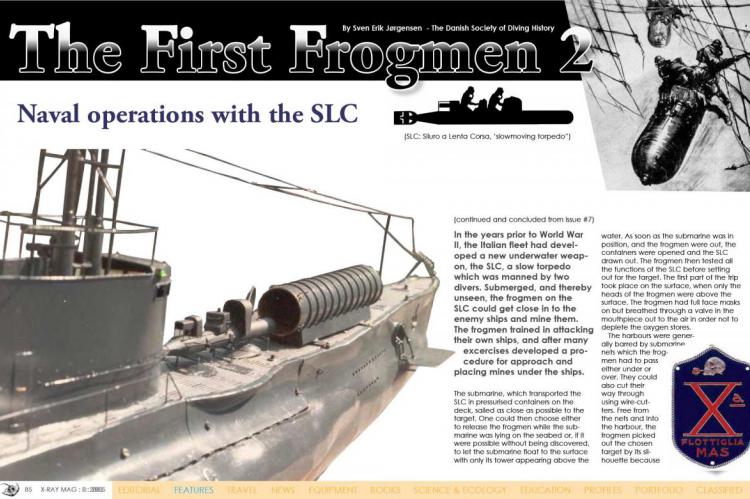
Originally published
X-Ray Mag #09
FOCUS: PHILIPPINES: Dumaguate - Ligpo Island - Malapascua - Dauin - Profile: Phil Nyutten :: Guadalupe Sharks :: Worlds Deepest Wreck Dive :: Portfolio: Ray Troll : Valentines Gifts :: The First Frogmen, part 2 :: Nova Scotia :: Photography and Travelling ... and much more more


